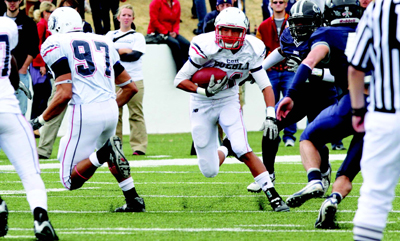Sep 29, 2017Hip Strength, Part II
To read the first installment of this article, on the basics for developing hip strength, read Hip Strength, Part I, found here.
I am a strong believer in specificity of training and selecting exercises that mimic in-game movements as much as possible. I keep three things in mind when designing any training program, including one that involves hip strengthening exercises.
First, because most of the athletes I train are playing their sport in a standing position, we rarely (if ever) train the hips in a seated or prone position. This eliminates most machine exercises and all stability ball exercises from our programs for hip strength. The only exception occurs when an athlete is injured and using a machine is the only viable training option.
I also limit exercises that involve movement at only one joint. Training one joint in isolation does not reflect what occurs during athletic movements. As I tell my athletes, even throwing a dart involves movement at more than one joint. As a result, performing hip flexion and extension movements on a multi-hip machine are not a point of emphasis. Instead, I select exercises that involve multiple muscle groups.

Finally, since my ultimate goal as a strength coach is to help athletes become as powerful as possible, I select exercises that are performed explosively. The more an athlete trains like they play, the better gains they will make, and this usually means training for explosiveness.
Based on these three stipulations, my preferred hip strengthening exercises are the weightlifting movements (cleans, jerks, snatches, and associated variations), performed either with a barbell or a dumbbell. No other human activity develops as much power output as the weightlifting movements. These exercises also develop eccentric strength in the hips because during the catch phase, the athlete has to slow down, control, and stop the barbell on its downward path.
The jump squat is another option that meets all three criteria, especially when training for high power output. As a safety measure, I prefer to have my athletes perform jump squats with dumbbells instead of barbells because it eliminates the opportunity for the barbell to bounce on an athlete’s back.
Squats–back, front, single-leg, and lateral–are all great hip strength developers. Back and front squats are not fancy or new, but they are tried and true exercises that add muscle mass and make athletes stronger. In short, they work.
When choosing which squats to use, I prefer to progress from less specific exercises to more specific exercises as an athlete’s competitive season approaches. I usually add single-leg squats to an athlete’s program when they are three to four months away from their competition phase.
Lateral squats are important because most sports involve lateral movement. They wouldn’t be high on my list for a 100-meter sprinter, but they are for virtually every other athlete I work with. Performed with a wide stance, our athletes alternate sides with each repetition.
Lunges–front, back, arch, and side–are also great exercises for hip strength. Lunges force athletes into a single-leg support position, which occurs in competition often. As useful as front lunges are, most athletes don’t always step directly forward in competition, so I make sure to include side and arch lunges as well.
These exercises make up the core of any program I design for hip strength. However, because the ultimate goal is to make athletes as powerful as possible, I also incorporate plyometric training to help facilitate the transfer of increases in strength to increases in power.
The primary plyometric drills to use for power development in the hips include box jumps, lateral box jumps, drop jumps to box jumps, and lateral drop jumps to lateral box jumps. In each exercise, emphasis should be placed on getting great speed off the floor and assuming an athletic stance upon landing.
Instead of having athletes perform plyometrics as a stand-alone activity, I have them use complex training, which means they move directly from a strength training activity to a plyometric activity. For example, they will do squats followed immediately by a set of box jumps.
I do this for two reasons. First, evidence suggests that complex training may produce superior results when compared to plyometric training alone. Second, we have a small space with a limited number of boxes for use. Complex training allows two athletes to work at each station at once since one athlete is jumping while the other athlete is performing the associated strength/power training movement.
Next week we’ll look at weightroom applications for hip strengthening exercises.



